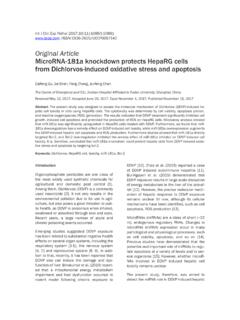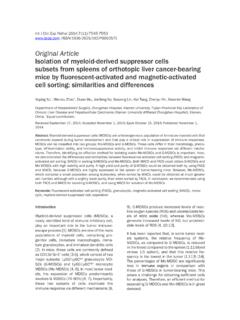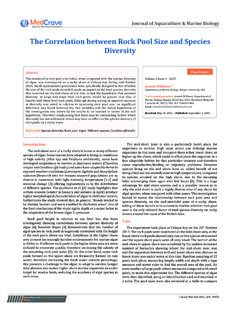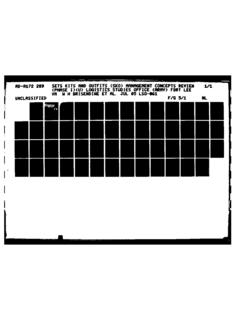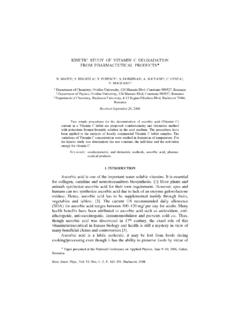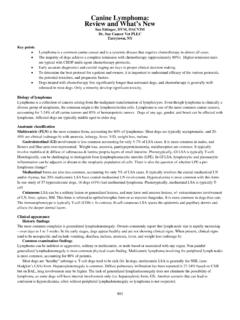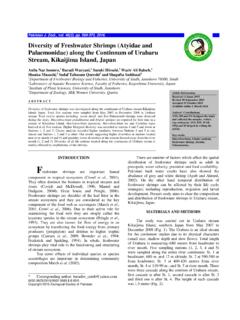Transcription of Original Article Overexpression of both VEGF-A …
1 Int J Clin Exp Pathol 2013;6(4):586-597 /ISSN:1936-2625/IJCEP1301019 Original ArticleOverexpression of both VEGF-A and vegf -C in gastric cancer correlates with prognosis, and silencing of both is effective to inhibit cancer growthXiaolei Wang1, Ximei Chen1, Jianping Fang2, Changqing Yang11 Department of Gastroenternology, Institute of Digestive Disease, Tongji Hospital, Tongji University School of Medicine, Shanghai 200065, PR China; 2 Department of Pathology, Tongji Hospital, Tongji University School of Medicine, Shanghai 200065, PR ChinaReceived January 9, 2013; Accepted February 26, 2013; Epub March 15, 2013; Published April 1, 2013 Abstract: Background: Vascular endothelial growth factor ( vegf )-A and vegf -C are two important molecules involv-ing in tumor development and metastasis via angiogenesis and lymphangiogenesis.
2 However, the combined effect of VEGF-A and vegf -C on the growth of gastric cancer (GC) is not clear. Methods: The correlations of VEGF-A and vegf -C expressions with clinicopathologic parameters and prognosis were evaluated in patients with GC. Further-more, lentivirus-mediated RNA interfering (RNAi) targeting VEGF-A and/or vegf -C was employed to silence their expressions in SGC7901 GC cell line. Cell proliferation and apoptosis were measured in vitro. Suppressive effect lentivirus-mediated VEGF-A and/or vegf -C silencing on GC growth was evaluated in GC bearing mice. Results: The patients with high expression of both VEGF-A and vegf -C (A+C+) had larger tumor size, higher peritumoral lym-phatic vessel density(P-LVD), microvessel density(MVD), lymphatic vessel invasion (LVI), lymph node(LN) metastasis, and worse prognosis than those with low expression of both VEGF-A and vegf -C (P< ).
3 Lentivirus-mediated RNAi significantly reduced the mRNA and protein expression of VEGF-A and vegf -C in the SGC7901 cells. The Lenti-miRNA- VEGF-A + vegf -C significantly inhibited the cell proliferation and tumor growth, compared with Lenti-miRNA- VEGF-A or Lenti-miRNA- vegf -C (P< ). In addition, Lenti-miRNA- VEGF-A + vegf -C markedly lowered the tumor size in vivo in comparison with Lenti-miRNA- VEGF-A or Lenti-miRNA vegf -C (P< ). Conclusion: Expressions of both VEGF-A and vegf -C predict worse prognosis of GC patients. Combined silencing of VEGF-A and vegf -C mark-edly suppresses cancer growth than silencing of VEGF-A or vegf -C. Thus, to inhibit the expressions of VEGF-A and vegf -C may become a novel strategy for the treatment of : Vascular endothelial growth factor-A, vascular endothelial growth factor-C, tumor growth, prognosis, gastric cancerIntroductionAlthough the incidence of gastric cancer (GC) is decreasing, it is still a leading cause of cancer related death in China, which is usually attrib-uted to its metastasis via lymph vessels and/or blood angiogenesis has been proved to be a prerequisite for the growth and progres-sion of solid malignancies.
4 Vascular endothelial growth factor ( vegf )-A is considered as a most potent factor in the angiogenesis through acti-vating receptor tyrosine kinases, vegf recep-tor-1 (VEGFR-1) and VEGFR-2 [1]. In GC patients, over-expression of VEGF-A is correlated with increase in microvessel density (MVD), hema-togenous metastasis, peritoneal dissemination and poor prognosis [2, 3]. However, although VEGF-A has been found to induce the lymphatic growth in the avascular cornea and promote the lymph node metastasis via vegf -C/-D/VEGFR-3- independent pathway in animals [4], its role in the lymphangiogenesis still remains undetermined in human the past few years, many studies have shown that tumor-induced lymphangiogenesis, driven by the lymphangiogenic growth factors (such as vegf -C and/or vegf -D) via VEGFR-3 signaling, VEGF-A , vegf -C and gastric cancer587 Int J Clin Exp Pathol 2013;6(4):586-597promotes the regional lymph node metastasis [5-7].
5 The increase in vegf -C expression has the positive correlation with lymphatic invasion, lymphatic vessel density, lymph node metasta-sis, and prognosis of many human cancers including GC [8-10]. However, a study showed the expression of VEGF-A or vegf -C alone is not an independent prognostic marker for patients with surgically resected gastric adenocarcino-ma [11].Recently, the anti-angiogenesis therapy (beva-cizumab) as an adjunct to chemotherapy has been applied in patients with advanced GC [12]. Therefore, we speculate that simultane-ous inhibition of VEGF-A and vegf -C may reduce cancer growth, progression and lym-phatic metastasis. However, most of previous studies in GC just focused the role of either VEGF-A or vegf -C in the biological behaviors of GC.
6 Our previous study showed that some of the GC patients have high expressions of both VEGF-A and vegf -C, who present with higher potential to induce lymph node metastasis, lymphatic vessel invasion (LVI), vascular inva-sion (VI), high MVD and poorer survival, com-pared with those having high expressions of both vegf -C and vegf -D, or both VEGF-A and vegf -D [13]. However, the significance of the different expression status of VEGF-A and vegf -C expression, both expressions of VEGF-A and vegf -C, compared with only VEGF-A expression, or vegf -C expression, in the GC is still this study, the correlations of VEGF-A and vegf -C expressions with clinicopathologic parameters and prognosis were evaluated in patients with GC.
7 Furthermore, lentivirus-medi-ated RNA interfering (RNAi) targeting VEGF-A and/or vegf -C was employed to silence their expressions in SGC7901 GC cell line. The influ-ence of VEGF-A and/or vegf -C on the biological behaviors of GC cells was and methodsPatients and sample collectionCancer specimens were obtained from 123 patients with primary GC who received gastrec-tomy in the Department of Surgery, Tong ji Hospital of Tong ji University from January 2000 to December 2003. None of them had received preoperative chemotherapy or radiotherapy. There were 80 men (65%) and 43 women (35%) with an average age of 65 years (range: 28-87 years) at the time of diagnosis. Thirty-one patients were diagnosed with early GC (EGC) and 92 with advanced GC (AGC).
8 Histological staging was done based on UICC TNM classifi-cation system. Other clinical features are sum-marized in Table 1. All patients were followed up for at least 5 years after surgery. The aver-age follow-up period was 56 months (range: 6-85 months). Overall survival (OS) was calcu-lated from the date of surgery to the last follow up. Eleven patients were diagnosed with perito-neal dissemination, 26 with liver metastasis, and 19 with recurrence after operation. Forty patients died of GC. The current study was approved by the Ethics Committee of Tong ji Hospital of Tong ji University. The work was con-ducted in accordance with the Declaration of Helsinki. Informed consent was obtained from all the patients in this study.
9 All the results were accomplished by two pathologists indepen-dently, and the means were calculated for each case based on the data for VEGF-A and vegf -CFor immunohistochemical staining, 4- m-thick paraffin-embedded sections were obtained. Sections were treated with H2O2 for 10 min at room temperature. For antigen retrieval, the sections were heated in mmol/L sodi-um citrate (pH ) in a microwave oven. Sections were then incubated at 4 C overnight in a humidity environment with primary anti-bodies (mouse monoclonal VEGF-A antibody [1:100, DAKO, Carpentaria, CA] and goat poly-clonal vegf -C antibody [1:100, Santa Cruz Biotechnology, Santa Cruz, USA]). Slides were rinsed thrice in mmol/L PBS for 2 min, and incubated for 30 min at room temperature with horseradish peroxidase (Envision, DAKO) conju-gated goat anti-rabbit/mouse secondary anti-body.
10 Development was done with 3 3-diami-nobenzidine. The normal goat IgG served as a negative control for vegf -C detection, and the normal rabbit IgG served as a negative control for VEGF-A of VEGF-A and vegf -C expres-sionsAssessment of VEGF-A and vegf -C expressions were done according to previously described [9]. The VEGF-A and vegf -C expressions were VEGF-A , vegf -C and gastric cancer588 Int J Clin Exp Pathol 2013;6(4):586-597semi-quantitatively determined according to the percentage of positive cancer cells. Staining intensity was classified as four grades: none (0), weak (1), moderate (2) and strong (3). The percentage of positive cancer cells was classi-fied as 4 grades: 0 (0%), 1 (1%-10%), 2 (11%-49%) and 3 (50%-100%). The total score was a product of two scores.



